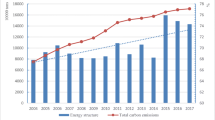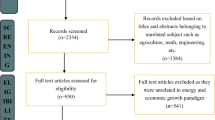Abstract
Measuring the magnitude of energy congestion provides useful information for determining the optimal level of energy input with reference to other inputs. This paper clarifies the concept of energy congestion and adapts a slacks-based DEA method to examine the energy congestion effect in Chinese industrial sectors over time. Our empirical results show that Chinese industrial sectors showed an increasing trend in energy congestion. The size of energy congestion effect varied across different provinces and regions. The central area had a significantly higher amount of energy congestion than that in west area, while the east area registered for the lowest energy congestion inefficiency. On average, 32 % of the energy consumption in Chinese industry was excessively used. A multiple regression analysis within a panel data analysis framework shows that the total energy consumption and industrial value added per capita have a positive while total-factor energy efficiency has a negative effect on energy congestion.



Similar content being viewed by others
Notes
In most cases, the amounts of energy congestion are the same as the total slack values obtained in Model (1), indicating that there is no plateau-like phenomenon as portrayed between points B and C in Fig. 1. This is probably because of the increasing number of input variables. Cooper et al. (2001) gave the same finding in their work. Flegg and Allen (2009) also pointed out that the use of Model (2) made little practical difference to the results.
The total-factor energy efficiency index is calculated using a non-radial directional distance function approach (Zhou et al. 2012), which seek to reduce energy input and expand output non-proportionally while keeping non-energy inputs constant.
References
Ang, B. W., Mu, A. R., & Zhou, P. (2010). Accounting frameworks for tracking energy efficiency trends. Energy Economics, 32, 1209–1219.
Apergis, N., & Payne, J. (2009). \({\rm CO}_{2}\) emissions, energy usage and output in Central America. Energy Policy, 37, 3282–3286.
Cooper, W. W., Deng, H. H., Gu, B. S., Li, S. L., & Thrall, R. M. (2001). Using DEA to improve the management of congestion in Chinese industries (1981–1997). Socio-Economic Planning Science, 35, 227–242.
Cooper, W. W., Thompson, R. G., & Thrall, R. M. (1996). Introduction: Extensions and new developments in DEA. Annals of Operations Research, 66, 3–45.
Färe, R., & Grosskopf, S. (1983). Measuring congestion in production. Zeitschrift für Nationalökonomie, 43, 257–271.
Färe, R., Grosskopf, S., & Lovell, C. A. K. (1985). The measurement of efficiency of production. Boston, MA: Kluwer Nijhoff Publishing.
Farrell, M. J. (1957). The measurement of productive efficiency. Journal of Royal Statistical Society Series A, 120(3), 253–290.
Flegg, A. T., & Allen, D. O. (2007a). Does expansion cause congestion? The case of the older British universities, 1994–2004. Education Economics, 15, 75–102.
Flegg, A. T., & Allen, D. O. (2007b). Using Cooper’s approach to explore the extent of congestion in the new British universities. Economic Issues, 12(Part 2), 47–81.
Flegg, A. T., & Allen, D. O. (2009). Congestion in the Chinese automobile and textile industries revisited. Socio-Economic Planning Science, 43, 77–192.
Honma, S., & Hu, J. L. (2008). Total-factor energy efficiency of regions in Japan. Energy Policy, 36, 821–833.
Hu, J. L., & Wang, S. C. (2006). Total-factor energy efficiency of regions in China. Energy Policy, 34(17), 3206–3217.
Im, K. S., Pesaran, M. H., & Shin, Y. (2003). Testing for unit roots in heterogeneous panels. Journal of Econometrics, 115, 53–74.
Kao, C. (2010). Congestion measurement and elimination under the framework of data envelopment analysis. International Journal of Production Economics, 123, 257–265.
Kneip, A., Simar, L., & Wilson, P. W. (2011). A computationally efficient, consistent bootstrap for inference with non-parametric DEA estimators. Computational Economics, 38, 483–515.
McFadden, D. (1978). Cost, revenue and profit functions. New York: Elsevier.
Noura, A. A., Lotfi, F. H., Jahanshahloo, G. R., Rashidi, S. F., & Parker, B. R. (2010). A new method for measuring congestion in data envelopment analysis. Socio-Economic Planning Science, 44, 240–246.
Pedroni, P. (2004). Panel cointegration: Asymptotic and finite sample properties of pooled time series tests with an application to the PPP hypothesis: new results. Econometric Theory, 20, 597–627.
Simões, P., & Marques, R. C. (2011). Performance and congestion analysis of the Portuguese hospital services. Central European Journal of Operations Research, 19(1), 39–63.
Song, M. L., Zhang, L. L., Liu, W., & Fisher, R. (2013). Bootstrap-DEA analysis of BRICS’ energy efficiency based on small sample data. Applied Energy, 112, 1049–1055.
Tone, K., & Sahoo, B. K. (2004). Degree of scale economies and congestion: A unified DEA approach. European Journal of Operational Research, 158, 755–772.
Wang, Q. W., Zhao, Z. Y., Zhou, P., & Zhou, D. Q. (2013). Energy efficiency and production technology heterogeneity in China: A meta-frontier DEA approach. Economic Modelling, 35, 283–289.
Wei, Q. L., & Yan, H. (2004). Congestion and returns to scale in data envelopment analysis. European Journal of Operational Research, 153, 641–660.
Wu, J., An, Q. X., Xiong, B. B., & Chen, Y. (2013). Congestion measurement for regional industries in China: A data envelopment analysis approach with undesirable outputs. Energy Policy, 57, 7–13.
Wu, F., Fan, L. W., Zhou, P., & Zhou, D. Q. (2012). Industrial energy efficiency with \({\rm CO}_{2}\) emissions in China: A nonparametric analysis. Energy Policy, 49, 164–172.
Zhang, N., & Choi, Y. (2013). Environmental energy efficiency of China’s regional economies: A non-oriented slacks-based measure analysis. The Social Science Journal, 50, 225–234.
Zhou, P., & Ang, B. W. (2008). Linear programming models for measuring economy-wide energy efficiency performance. Energy Policy, 36, 2901–2906.
Zhou, P., Ang, B. W., & Han, J. Y. (2010). Total factor carbon emission performance: A Malmquist index analysis. Energy Economics, 32, 194–201.
Zhou, P., Ang, B. W., & Wang, H. (2012). Energy and \({\rm CO}_{2}\) emission performance in electricity generation: A non-radial directional distance function approach. European Journal of Operational Research, 221, 625–635.
Acknowledgments
The authors are grateful to the financial support provided by the National Natural Science foundation of China (Nos. 71273005 & 71203055), the Jiangsu Natural Science Foundation for Distinguished Young Scholar (No. BK20140038), the Funding of Jiangsu Innovation Program for Graduate Education (CXLX13_170), the Humanities and Social Science Foundation of the Ministry of Education (No. 12YJCZH039), the Ph.D. Programs Foundation of Ministry of Education of China (No. 20123218110028) and the NUAA research funding (No. NE2013104).
Author information
Authors and Affiliations
Corresponding author
Rights and permissions
About this article
Cite this article
Wu, F., Zhou, P. & Zhou, D.Q. Measuring Energy Congestion in Chinese Industrial Sectors: A Slacks-Based DEA Approach. Comput Econ 46, 479–494 (2015). https://doi.org/10.1007/s10614-015-9499-2
Accepted:
Published:
Issue Date:
DOI: https://doi.org/10.1007/s10614-015-9499-2




